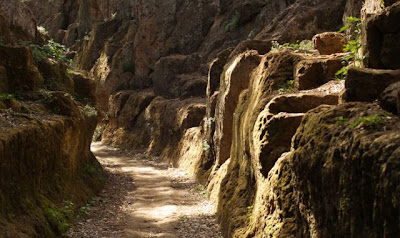
Houses for the Living...
Houses for the Dead...
"Crossing the threshold of the cemetery, each of them [the Etruscans of Cerveteri] possessed a second house."
"Inside this house, a resting place was already prepared. And soon, they would be lying down alongside their forefathers."
"Eternity, therefore, was not a vague illusion. Nor a mere fairy tale. Nor an insubstantial promise by their priests."
Giorgio Bassani,
The Garden of the Finzi Continis
An aerial view of the Etruscan Necropolis of Cerveteri,
showing rounded tumuli, above, and rectilinear chamber tombs, below.
We walk along the streets of this seeming city - popping in and out of tombs. Like casual calls on friends and neighbors, on a pleasant holiday when everyone is home.
We can reach out and touch the Etruscan afterlife - or so we like to think. But this is a laughable impertinence on our part. The perennial license of the living to play fast and loose with the dead.
Simple interments in the rock; an excavated sarcophagus
is seen at the right, in deep shadow.
But...the incredible concreteness of it all! For once, the Mysterious Etruscans seem diagrammatically clear.
Broad avenues are lined with rows of rectilinear tombs, boasting fine facades of dressed stone.

A fine range of chamber tombs, faced with dressed stone, with
bold foundation courses and elaborate moldings at the roof line.
Inside, we see chambers hewn with elegant precision from the native rock.
The interior of a chamber tomb; the triangular headpiece
at the right marks a male interment; women
were indicated by semi-circular disks.
Most imposing of all are the tumuli, grassy domes ringed with finished stone...
A range of monumental tumuli, evoking the forms
of traditional round houses.


In the course of five hundred years (from the Eighth through the Fourth Centuries B.C.), there were periods of greater and lesser wealth and power, evolving social customs and emerging religious beliefs.
And all of these forces shaped the local topography.
And then we climb back in our cars and drive away - after the inevitable stand-off between the living and the dead.
Our Photographer confronts Eternity.
of traditional round houses.
... hiding grandiose burial chambers...

Inside the tumulus of the noble Matuna family.
...lavishly decorated with the appurtenances of aristocratic life.
Renderings of the Matuna tomb decorations
by A.N. Des Vergers (Paris, 1862)
But who were the people buried here?

Terracotta sarcophagus lids from Cerveteri,
in the Villa Giulia Museum in Rome.
Sarcophagus of the Married Couple from Cerveteri,
in the Villa Giulia Museum in Rome.
We hear that Etruscan society was rigidly hierarchical - and this is the seeming proof. Dominated by the elegant and self-possessed individuals who smile at us from frescoes and sarcophagus lids. Re-enacting the pleasures of their privileged lives.
in the Villa Giulia Museum in Rome.
At Cerveteri, we see free-standing mansions, comfortable row houses...and mere holes in the ground. But this is a tourist trick that we play on ourselves - reducing history to urban real estate.
In the course of five hundred years (from the Eighth through the Fourth Centuries B.C.), there were periods of greater and lesser wealth and power, evolving social customs and emerging religious beliefs.
And all of these forces shaped the local topography.
at the left; chamber tombs, at the right.
So, the Etruscans of Cerveteri remain as mysterious as we want them to be.
A road leads to an Etruscan tumulus; in the midground,
the round opening to a subterranean burial place;
at the left, a wall of cut stone.
the round opening to a subterranean burial place;
at the left, a wall of cut stone.
And then we climb back in our cars and drive away - after the inevitable stand-off between the living and the dead.
A rental car from Florence, parked in sparse shade near a
massive tumulus outside the main archeological zone.
(No mystery here; the camera is on remote control.)
PHOTOGRAPHS:
Ten views of Cerveteri © Lyle Goldberg
Five images from the web (numbers 2, 3, 9, 10 & 11)











Hello there! I found you on the history blog ~ I loved your comments; had a great laugh, actually. I am excited about perusing through your website. Cheers ~ alice
ReplyDeleteThis is amazing! I just enjoyed every word, every description and every photo. I find it very interesting how social heirarchies seem to be the plague of human nature ~ our complete inability to live harmoniously equal, without pretension.
ReplyDeleteHuman nature, I suppose is what makes us human -and also, what makes history both wonderful and horrible. I am sure that Oscar Wilde would have had a quick comeback about the sheer unattractiveness of "living without pretension", but he never seems to be around when you need him!
ReplyDeleteHuman nature, I suppose is what makes us human -and also, what makes history both wonderful and horrible. I am sure that Oscar Wilde would have had a quick comeback about the sheer unattractiveness of "living without pretension", but he never seems to be around when you need him!
ReplyDeleteI agree ~ for me the most alluring aspect of history is the study of human nature and its seemingly consistent, predictable behavior and reactions, despite cultural differences, time or "modernity." I have to admit, I had to do some research on Oscar Wilde, after your previous statement ~ what an interesting character ~ you have given me a new subject to study!!
ReplyDeleteThanks very much for your pictures and descriptive narrative. My wife and I were in Cerveteri in 2006, and we were enthralled by all things Etruscan. Facinating.
ReplyDeleteI have visited a lot of Etruscan sites in the course of my many years in Florence but Cerveteri really does have a unique presence.
ReplyDelete